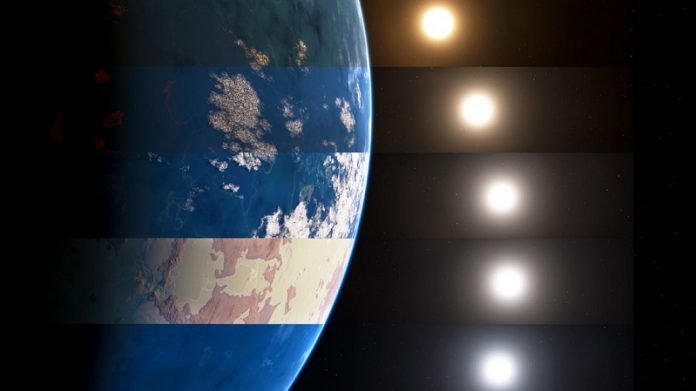
After examining a dozen types of suns and a roster of planet surfaces, Cornell astronomers have developed a practical model – an environmental color “decoder” – to tease out climate clues for potentially habitable exoplanets in galaxies far away.
“We looked at how different planetary surfaces in the habitable zones of distant solar systems could affect the climate on exoplanets,” said Jack Madden, Ph.D. ’20.
“Reflected light on the surface of planets plays a significant role not only on the overall climate,” Madden said, “but also on the detectable spectra of Earth-like planets.”
Madden and Kaltenegger are co-authors of “How Surfaces Shape the Climate of Habitable Exoplanets,” released the Monthly Notices of the Royal Astronomical Society.
In their research, they combine detail of a planet’s surface color and the light from its host star to calculate a climate.
For instance, a rocky, black basalt planet absorbs light well and would be very hot, but add sand or clouds and the planet cools; and a planet with vegetation and circling a reddish K-star will likely have cool temperatures because of how those surfaces reflect their suns’ light.
“Think about wearing a dark shirt on a hot summer day. You’re going to heat up more, because the dark shirt is not reflecting light. It has a low albedo (it absorbs light) and it retains heat,” Madden said. “If you wear a light color, such as white, its high albedo reflects the light – and your shirt keeps you cool.
It’s the same with stars and planets, Kaltenegger said.
“Depending on the kind of star and the exoplanet’s primary color – or the reflecting albedo – the planet’s color can mitigate some of the energy given off by the star,” Kaltenegger said. “What makes up the surface of an exoplanet, how many clouds surround the planet, and the color of the sun can change an exoplanet’s climate significantly.”
Madden said forthcoming instruments like the Earth-bound Extremely Large Telescope will allow scientists to gather data in order to test a catalog of climate predictions.
“There’s an important interaction between the color of a surface and the light hitting it,” he said. “The effects we found based on a planet’s surface properties can help in the search for life.”
The Brinson Foundation and the Carl Sagan Institute supported this research.
Written by Blaine Friedlander.



